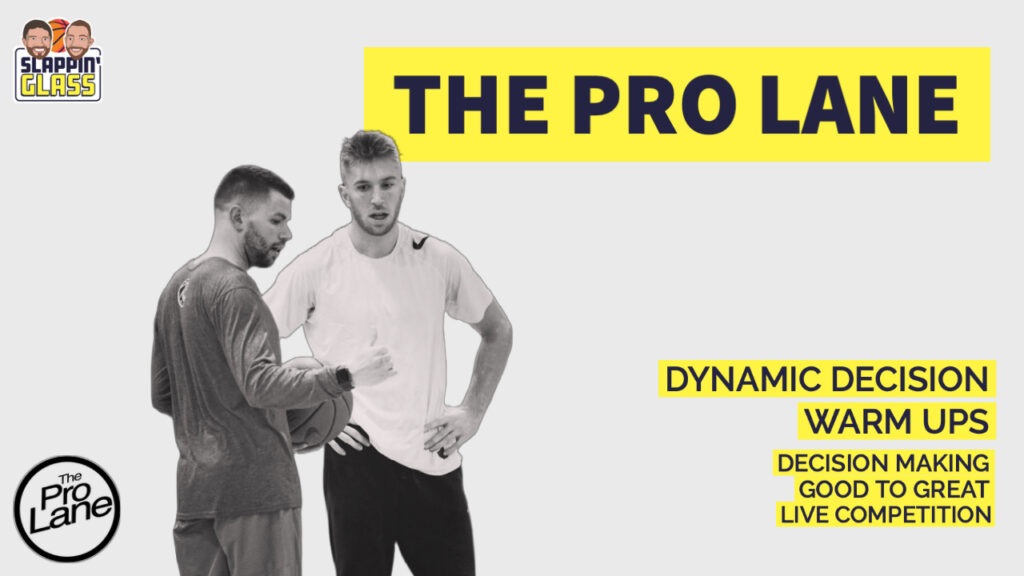Over the past year and a half, we have enjoyed getting to know and work with Drew Dunlop and Jake Grossmann, founders of The Pro Lane. We have collaborated with them on past video breakdowns to explore how they think about and train skill development in their practice sessions. Based on these previous experiences, we had a fantastic podcast conversation with them on how coaches can incorporate skill and concept development into their own sessions, particularly during the first 10 to 15 minutes of “warm-up” part of practice.
We know that during the course of a season coaches are always balancing resources, energy, and court time to focus not only on player development but also on team tactics (offensively and defensively), scouting, and game preparation. Finding opportunities to devote a large portion of time to individual development can be challenging. Perhaps a solution can be found in the warm-ups, and using the first 10-15 minutes to provide players with valuable reps dedicated to developing skills, decision-making, and core concepts.
With the aid of The Pro Lane, we have assembled a variety of drills that coaches can use as a framework to help stimulate thought on how one can organize and constrain warm-up drills to help develop skills, as well as get quality offensive and defensive reps based around schematic concepts. Below we have pulled out a few of the main themes, constraints, and ideas discussed throughout the breakdown.
Time vs Dribble Constraint: A major theme throughout all the drills shown in the video is the emphasis on developing quicker decisions. As we discussed recently on the podcast with Basketball Australia’s Head of High Performance Coaching, Peter Lonergan, the sneaky downside to using the constraint of “limiting dribbles” during drills is that it can often leads to tough shots, bad ideas, and limits a player’s creativity.
An important facet of any drill is its ability to provide proper game context. So while one player can find a proper solution in three dribbles, perhaps another player needs an extra dribble or two to arrive at the same solution. As Coach Lonergan mentions, perhaps a better constraint and point of emphasis within these drills should be properly emphasizing the time required to reach a solution since every possession has a shot clock (unless you are coaching basketball in one of the states in the U.S. that doesn’t use a shot clock…).
Disruptive Control: As discussed in the breakdown, within any competitive drill, there will always be a “push-pull” relationship between the offense and the defense. In order for either of them to improve, the other one has to either push them to be better or pull them up to their level. Therefore, it is important that the defense exhibits “disruptive control” in challenging the offense to be better. They can do this by mixing up their coverages and stunts to avoid being predictable and challenging the offense to read and react.
Not only do the shown drills condition offensive solutions, but they also help in repping valuable defensive skills and decision-making. The defense can be constrained in different ways to force the players to work on specific defensive coverages, concepts, and footwork solutions.
Offense vs Defense Trigger Starts: The goal of this project is to provide a framework for coaches to work off of, and provide an understanding of how one drill can be changed or adjusted to work different skills. One such aspect can be found in determining who triggers the start of the drill. If the offense triggers the start, the defense will be at the disadvantage and must work towards finding solutions to neutralize it. Some examples are working with stunts to buy time or playing through defensive help concepts, such as the peel switch.
However, if the defense triggers the start, the offensive player must perceive where the open space is and work with a change of pace and/or change of direction in creating an advantage.
Play it Down (PID): “Play it Down” or “PID” as the kids call it, is a clever tool in structuring drills to maximize the number of decisions and reps within one set. If a drill begins as 3v3, then it can progress down to 2v2 and finally 1v1 after each shot attempt, with the shooter and defender stepping off. This allows each player to be an active participant within the drill and make valuable reads and decisions on both sides of the ball to help grow their game. A variety of “PID” examples are shown in the breakdown.
Limit your Menu: Today’s breakdown runs through a lot of different drills, which may seem like a challenge in thinking about how to implement them all. To which we would say, “Don’t.” Each drill has a learning curve for both players and coaches. So start with less and allow your players to grasp and comprehend the drill, while also learning how you and your staff can present new challenges and constraints within the drills to elicit desired skills or solutions. The goal is not necessarily to have a large number of drills but rather a few key drills that can be built upon to provide breadth and depth. Changing starts, spacing, locations or finishing solutions can go a long way in keeping the drill fresh and challenging the players.
To see all these drills in actions and hear more on drill constraints and ideas. Including:
- Good to great shooting solutions
- Working off of secondary actions
- Rundown timing
- “Paintball” scoring
View the full breakdown now on SGTV!
